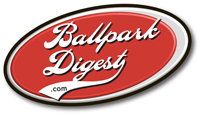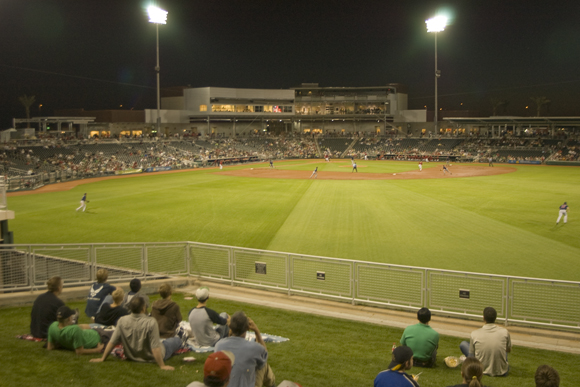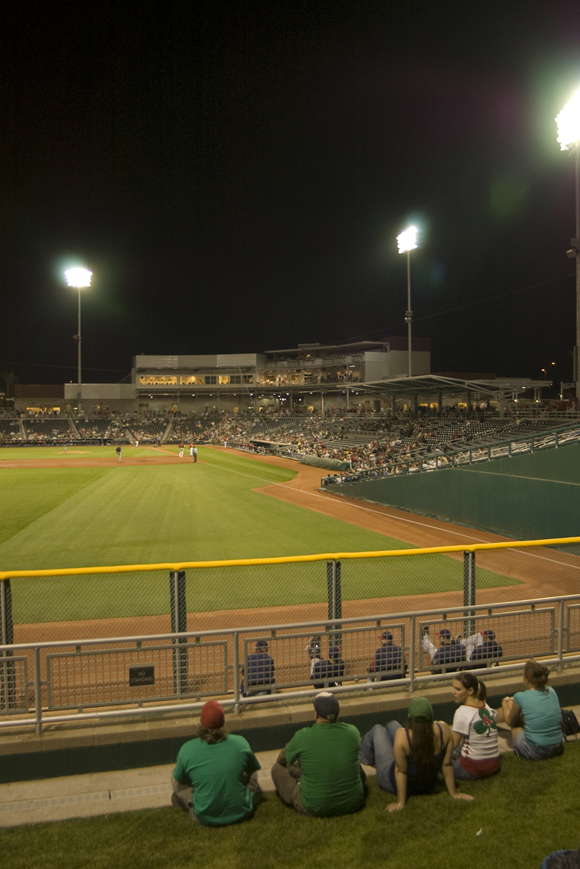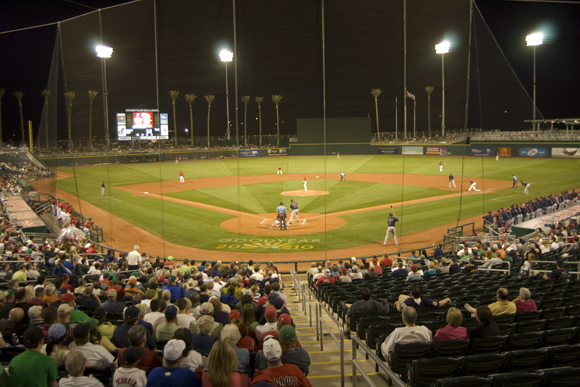Goodyear, located on the far western edge of the greater Phoenix area, isn’t the first place to come to mind when brainstorming for the ideal spring-training locale. But the new spring home of the Cleveland Indians and Cincinnati Reds combines state-of-the-art training complexes with one of the more pleasant ballparks in the Cactus League, in a setup sure to please fans and management alike.
FAST FACTS
Capacity: 8,000 fixed seats, 500 premium seats, 1,600 berm seats, 400-seat party area, 6 suites
Cost: $100 million
Owner: City of Goodyear
Architect: Populous, Kansas City
Construction: Barton Malow
Tenants: Cleveland Indians (2009-present), Cincinnati Reds (2010-present)
Address: 1933 S. Ballpark Way, Goodyear.
Directions: Goodyear is located in the southwest corner of the greater Phoenix area. From I-10, take Estrella Parkway South. Continue on Estrella Parkway; you’ll see the ballpark on your left after you pass Van Buren. Signage from the freeway may take you a slightly different route, but that’s OK; pretty much anything heading south of the freeway will lead you to the ballpark.
Goodyear, located on the far western edge of the greater Phoenix area, isn’t the first place to come to mind when brainstorming for the ideal spring-training locale. True, it’s growing like mad – the population rose from 18,911 in 2000 to an estimated 55,954 in 2007 – and many large businesses, including Lockheed, Macy’s and Lufthansa, have large-scale operations there.
And any city experiencing rapid growth in the Valley of the Sun sets their sights on one thing: spring training. For the Cleveland Indians, a spring-training match was made in heaven: the city is named after the Ohio-based tire manufacturer, and the firm had operations in the city for decades.
Besides a growing population, Goodyear has two other things important to landing spring training: money and land. Both play out in the city’s spring-training district, which features an 8,000-seat ballpark and training complexes for the Indians and the Cincinnati Reds. Once an entertainment/retail district is added to the mix — and we’re confident it will, despite some issues with the original developer, as there’s plenty of new development popping up along Estrella Parkway — you have the makings of a great spring-training atmosphere.
Still, we’re guessing the planning of the ballpark represented a challenge to architects David Bowers and Steve Boyd. There is little more at the Goodyear ballpark site than, well, land. The site is next to a small commuter airport and Lufthansa training base, with the standard Arizona mountains and buttes in the background. Aside from housing developments on the other side of Estrella Parkway, there’s little else in the area past agricultural field. No context at all.
So it’s a little surprising how well Goodyear Ballpark works. With an emphasis on rough and natural materials, the ballpark features a unique three-story grandstand design, some curves reminiscent of Chain of Lakes Park, and intimate seating bowl where you’re never far from the action.
After a behind-the-scenes tour – thanks to Andrew Miller of the Indians – and attending several games, we came away with the following.
1) Goodyear Ballpark is a deceptively simple ballpark, even for a spring-training facility. The ballpark consists of a grandstand, seating extending down each line to the foul poles, wraparound concourse, concession booth as part of the batters’ eye, a large outfield berm, and a right-field party deck sitting on top of the clubhouses and batting cages. Within the grandstand’s main level are a team store, concessions and restrooms. As you can tell from the accompanying photos, the grandstand is a very vertical space, creating a nice little tension with the horizontal lines that so dominate the local landscape.
2) The vertical grandstand feature some of the nicest spots to watch a Cactus League game. On the second level are a smaller press box and six suites. The suites are nontraditional, more akin to a party zone than anything else. The only permanent fixture in the suite is a half-moon-shaped bar in the middle of the space, perfect for a group standing around and watching a game. A garage-door style set of windows can be opened to a table and chairs set up on the patio. The feel, we expect, will be that of a casual gathering, with groups circling the bar and watching the game from the inside of the suite. The suite layout is a nice touch for the spring-training vibe.
On the top floor of the grandstand is a large group area. It can be sold in different ways – for larger or midsized groups, or as a general party area when nothing else is going on. The view of the field is great, as is the view of the surrounding area: you can see University of Phoenix Stadium in the distance.
3) Because there are no training facilities at the ballpark, fans will have a short distance between their cars and the front gates. Four entrances provide entry to the ballpark, and although the main gate is the farthest away from the largest parking areas, we’d recommend fans walk to the incredible home-plate plaza and hang out a little bit before entering the ballpark. Water fountains and a 60-foot, six-inch-high baseball statue provide a great atmosphere.
4) The 400-capacity right-field party deck, featuring all-you-can-eat events, has proven to be one of the more popular party areas in the Cactus League. It’s a nice, defined space with a good view of the action and a great vantage point for watching players come and go (it sits above the clubhouses). Tables and chairs accentuate the casual atmosphere. The massive bar is on wheels, allowing the space to be reconfigured for different events.
5) The design aesthetic is rustic, with nods toward the area’s agricultural heritage in the use of galvanized steel throughout. The design is consistent, with mobile points of sale and outbuildings (a portable team store and ticket booth in the center-field entrance) sporting the same look.
6) Kids are very welcome at the ballpark – and that’s not always so in spring-training facilities. A Wiffle-ball field in the right-field corner provides a welcome diversion to kids bored with baseball, and a large open area in the left-field corner is a good place to run around. There’s room on the berm for 1,600 or so.
7) Concessions are not overwhelming. There are plenty of mobile points of sale on the concourse, with two main stands in the grandstand and another in the center-field batter’s eye.
We also took an extensive tour of the Indians training facility. Splitting off the training facility from the ballpark is something that’s fallen out of favor in the Cactus League – recent complexes like Surprise Stadium have been built with everything integrated – but Goodyear presents a compelling argument toward keeping the two separate.
For starters, the arrangement keeps the ballpark open outside of spring training for youth and college tourneys, concerts and other events. The clubhouses temporarily used by each team for spring training will be open the rest of the year, and the venue will be free and clear for almost anything the four-person Goodyear stadium authority can book – including a possible move of the MLB winter league from Hawaii to Arizona.
It also gave the Indians a state-of-the-art training facility. With two MLB fields (one built to Progressive Field’s dimensions), four minor-league fields, smaller practice fields, a slew of batting cages and pitching mounds, it’s a place where the Indians can run operations year-round while giving the team some flexibility. For instance, the four minor-league diamonds are under control of the Indians only for spring training and extended spring training; they can be used for youth tournaments the rest of the year.
The goal with the training facility, according to the Indians’ Miller, was to give the Indians a place to focus on player development year-round. As such, it presents one of the best approaches to player development we’ve seen in a single complex (the new Dodgers/White Sox complex in Glendale similarly advances the state of the art; we’ll look at it on Monday) and sets a high bar for teams looking to upgrade their operations.
A dramatic three-story entrance, a soaring space that’s a marked contrast to the largely horizontal lines in the area, sets the tone for the entire facility. Upstairs are the team offices, including a large suite for the Indians GM with a private deck overlooking the two main practice fields.
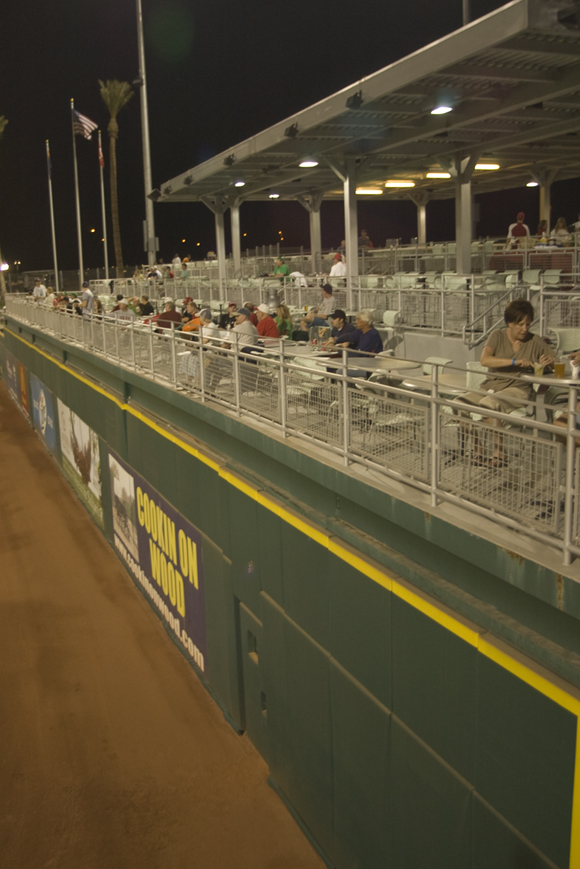
Downstairs is where the player facilities are. Three clubhouses can house over 200 players during spring training. As you might expect, the MLB clubhouse is the swankest: the lockers are arranged in such a way that there are no corners in the room, creating a very egalitarian space. The AAA/AA clubhouse isn’t as nice – the decorative finishes found in the MLB clubhouse are largely gone, and players have less room to move around – and the A clubhouse is very basic. That was purposeful, according to Miller: give the younger players something to shoot for.
There’s really not much difference between the MLB and MiLB spaces: they run parallel, with shared facilities like a 4,000-square-foot workout room and hydrotherapy area. If anything, the tone of the two areas is different: the artwork on the MLB side focuses on the long and proud history of the Indians, while the artwork on the MiLB side focuses on current stars – reminders to the minor leaguers that hard work can lead to stardom.
